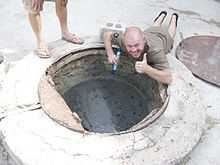LifeStraw

LifeStraw is a water filter designed to be used by one person to filter water so that they may safely drink it. It filters a maximum of 1000 litres of water, enough for one person for one year. It removes almost all of waterborne bacteria and parasites.[1] The LifeStraw Family, a larger unit designed for family use, also filters out nearly all microbes.[2]
LifeStraw includes LifeStraw and LifeStraw Family, which are complementary point-of-use water filters designed by the Swiss-based Vestergaard Frandsen for people living in developing nations and for distribution in humanitarian crisis. LifeStraw Family filters a maximum of 18,000 litres of water, providing safe drinking water for a family of five for up to three years.
LifeStraw and LifeStraw Family were distributed in the 2010 Haiti earthquake, 2010 Pakistan floods, and 2011 Thailand floods. In the Mutomo District in Kenya which has suffered from long term drought, the Kenya Red Cross supplied filters to 3,750 school children and 6,750 households.[3] In 2015, LifeStraw filters were deployed in Rwanda.[4]
Construction
The LifeStraw is a plastic tube 310 mm long and 30 mm in diameter.[5] Water that is drawn up through the straw first passes through hollow fibres that filter water particles down to 0.2 µm across, using only physical filtration methods and no chemicals.[6] The entire process is powered by suction, similar to using a conventional drinking straw, and filters up to 1000 litres of water.[7] While the initial model of the filter did not remove Giardia lamblia,[8] LifeStraw now removes a minimum of 99.9% of waterborne protozoan parasites including Giardia and Cryptosporidium.[9]
Critical response
LifeStraw has been generally praised for its effective and instant method of bacteria and protozoa removal and consumer acceptability.[10] Paul Hetherington, of the charity WaterAid, has criticised the LifeStraw for being too expensive for the target market. He also points to other important problems linked with accessing the water in developing countries, which wait to be solved, but are not addressed by the device itself.[11]
Although LifeStraw is available for retail sale in the developing world, the majority of LifeStraw are distributed as part of public health campaigns or in response to complex emergencies by NGOs and organizations that give them away for free in the developing world.[12]
LifeStraw has been praised in the international media and won several awards including the 2008 Saatchi & Saatchi Award for World Changing Ideas, the ‘INDEX: 2005’ International Design Award and "Best Invention of 2005" by Time Magazine.[13]
See also
- LifeSaver bottle
- Tata Swach
- Slingshot (water vapor distillation system)
- Portable Aqua Unit for Lifesaving
References
- ↑ LifeStraw Features
- ↑ LifeStraw Family Features
- ↑ Muasya, Phillip (July 1, 2011). "Kenya: Lifestraw Water Filters Saving Lives in Mutomo". The Star. Retrieved 17 March 2013.
- ↑ Thiebes, Joseph (2015-02-23). "SWEETLab deploys half million water filters in Rwanda". Portland State Vanguard. Retrieved 2015-04-21.
- ↑ Friend, Gil. "The LifeStraw". Worldchanging - Evaluation + Tools + Best Practices. Retrieved 2015-04-21.
- ↑ http://www.trcommons.org/2010/11/disruptive-technology-lifestraw-cleans-dirty-water-to-usepa-standards/ Tufts Roundtable Commons
- ↑ Longevity and efficacy
- ↑ Water for the World, MSNBC, By Jennie Yabroff, 6/12/07.
- ↑ , Vestergaard Frandsen: Does LifeStraw remove parasites like cryptosporidium and giardia?
- ↑ customer acceptability
- ↑ New straw to kill disease as you drink
- ↑ The force behind LifeStraw
- ↑ Awards and Accolades